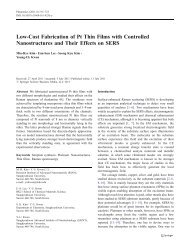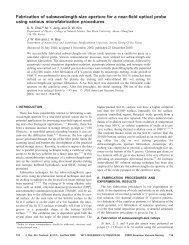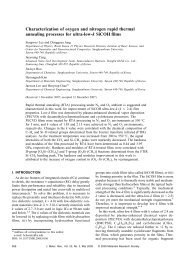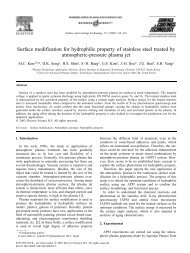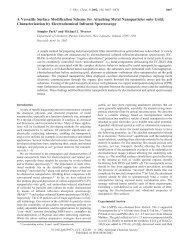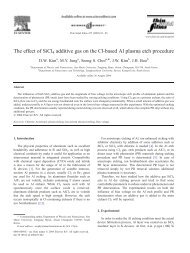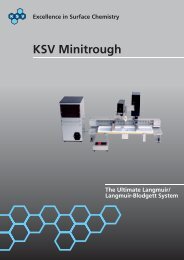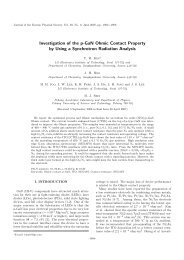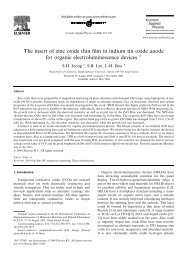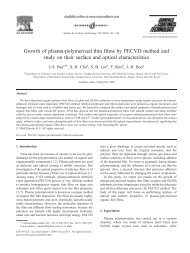Selective MOCVD of titanium oxide and zirconium oxide thin films ...
Selective MOCVD of titanium oxide and zirconium oxide thin films ...
Selective MOCVD of titanium oxide and zirconium oxide thin films ...
- No tags were found...
You also want an ePaper? Increase the reach of your titles
YUMPU automatically turns print PDFs into web optimized ePapers that Google loves.
132ARTICLE IN PRESSB.-C. Kang et al. / Journal <strong>of</strong> Physics <strong>and</strong> Chemistry <strong>of</strong> Solids 69 (2008) 128–132<strong>and</strong> growth during the deposition [23]. In this experiment,OTS can prevent nucleation for TiO 2 <strong>and</strong> ZrO 2 <strong>thin</strong> film onthe SAMs surfaces because it has hydrophobic terminalgroup (–CH 3 ), i.e., there are no reaction factors forchemisorption between the metal-organic (MO) precursors<strong>and</strong> –CH 3 groups. But the MO precursors can obtainelectrons from the ‘‘base’’ originated from native <strong>oxide</strong>layers on the Si(1 0 0) surface <strong>and</strong> they can makechemisorptions with substrate very strongly. After all, <strong>thin</strong>film is able to be formed on it. However, OTS SAMs areweak in respect <strong>of</strong> thermal stability over 450 1C [25], theyshould change their identities or make some defects on theOTS SAMs area. Therefore, it is difficult to make <strong>thin</strong> <strong>films</strong>selectively on substrates by combination <strong>of</strong> mCP <strong>and</strong><strong>MOCVD</strong> methods at high temperatures. Thomas et al.showed that Ti(O i Pr) 2 (tbaoac) 2 precursor showed slightlysuperior properties in terms <strong>of</strong> evaporation behavior,deposition temperature, <strong>and</strong> smaller amount <strong>of</strong> residuematerial than those <strong>of</strong> Zr(O i Pr) 2 (tbaoac) 2 precursor [24].And Zr(O i Pr) 2 (tbaoac) 2 precursor could induce high v<strong>and</strong>er Waals force with OTS SAMs surface <strong>and</strong> lowmolecular mobility on the OTS SAMs area owing to itshigh molecular weight compared to Ti(O i Pr) 2 (tbaoac) 2 .These disadvantage factors should require a long nucleationtime on the Si(1 0 0) substrate <strong>and</strong> cause less siteselectivedeposition than that <strong>of</strong> TiO 2 in our experiment.4. ConclusionsWe successfully deposited patterned TiO 2 <strong>and</strong> ZrO 2 <strong>thin</strong><strong>films</strong> directly using a combination method <strong>of</strong> mCP <strong>and</strong><strong>MOCVD</strong> methods. New developed precursors <strong>of</strong>[M(O i Pr) 2 (tbaoac) 2 ,M¼ Ti, Zr] were used as precursorsfor TiO 2 <strong>and</strong> ZrO 2 <strong>thin</strong> <strong>films</strong>. In the case <strong>of</strong> TiO 2deposition, it showed a good selectivity growth on thepatterned Si(1 0 0) substrate. The boundaries between theOTS SAMs area <strong>and</strong> TiO 2 deposited area were very cleancut <strong>and</strong> sharp without any breaks. The micro-Ramanspectroscopy <strong>and</strong> the EDX data showed that the depositedTiO 2 <strong>thin</strong> <strong>films</strong> were stoichiometric with anatase phase. Inthe case <strong>of</strong> ZrO 2 <strong>thin</strong> <strong>films</strong>, they showed a selectivedeposition on the substrate as deposition time below 2 h;however, the selectivity disappeared above 2 h. It meansthat OTS should change or lose its identity due to hightemperature <strong>and</strong>/or long deposition time. Even though thecombination <strong>of</strong> <strong>MOCVD</strong> <strong>and</strong> mCP is a very convenienttechnique to make micro-size structures without involvingphotolithographic-type procedures, there are some limitationssuch as deposition temperature <strong>and</strong> deposition time.However, it is expected that the combination <strong>of</strong> mCP<strong>of</strong> SAMs <strong>and</strong> <strong>MOCVD</strong> is a better method for fabricatingmicro-size, various functional <strong>thin</strong> <strong>films</strong> at lowtemperatures.AcknowledgmentsThe authors gratefully acknowledge the support by theBK21 project <strong>of</strong> Ministry <strong>of</strong> Education, Korea.References[1] K.S. Goto, Solid State Electrochemistry <strong>and</strong> its Applications toSensors <strong>and</strong> Electronics Devices, Elsevier, New York, 1988.[2] L.A. Ryabova, Current Topics in Materials Science, vol. 7, North-Holl<strong>and</strong>, Amsterdam, 1981 (Chapter 5).[3] M.F. Yan, W.W. Rhodes, Grain Boundaries in Semiconductors,North-Holl<strong>and</strong>, New York, 1981.[4] J. Reintjes, M.B. Schultz, J. Appl. Phys. 39 (1968) 5254.[5] S.J. Tauster, S.C. Fung, R.L. Garten, J. Am. Chem. Soc. 100 (1978)170.[6] D.J. Dwyer, S.D. Cameron, J. Gl<strong>and</strong>, Surf. Sci. 159 (1985) 430.[7] J. Robertson, J. Vac. Sci. Technol. B 18 (2000) 1785.[8] R. Nowak, S. Maruno, Mater. Sci. Eng. A 202 (1995) 226.[9] S. Noda, J. Tepsanongsuk, Y. Tsuji, Y. Kajikawa, Y. Ogawa,H. Komiyama, J. Vac. Sci. Technol. A 22 (2) (2004) 332.[10] Y. Murayama, J. Vac. Sci. Technol. 12 (4) (1975) 818.[11] H.B. Nie, S.Y. Xu, S.J. Wang, L.P. You, Z. Yang, C.K. Ong, J. Li,T.Y.F. Liew, Appl. Phys. A 73 (2001) 229.[12] Y. Gao, K. Koumoto, Crystal Growth Des. 5 (5) (2005) 1983.[13] Y. Xia, G. Whitesides, Angew. Chem. Int. Ed. 37 (1998) 550.[14] A. Kumar, H.A. Biebuyck, N.L. Abbott, G.M. Whitesides, J. Am.Chem. Soc. 114 (1992) 9188.[15] N.L. Jeon, R.G. Nuzzo, Y. Xia, M. Mrksich, G.M. Whitesides,Langmuir 11 (1994) 3024.[16] A. Folch, M.A. Schmidt, IEEE J. Microelectromech. Syst. 8 (1)(1999) 85.[17] B.-C. Kang, J.-H. Lee, H.-Y. Chae, D.-Y. Jung, S.-B. Lee, J.-H. Boo,J. Vac. Sci. Technol. B 21 (4) (2003) 1773.[18] R. Bhakta, F. Hipler, A. Devi, S. Regnery, P. Ehrhart, R. Waser,Chem. Vap. Depos. 9 (2003) 295.[19] U. Patil, M. Winter, H.-W. Becker, A. Devi, J. Mater. Chem. 13(2003) 2177.[20] B.-C. Kang, S.-B. Lee, J.-H. Boo, Surf. Coatings Technol. 131 (2000)88.[21] Y.H. Zhang, C.C. Chan, J.F. Porter, W. Guo, J. Mater. Res. 13(1998) 2602.[22] T.D. Robert, J.D. Laude, V.M. Geskin, R. Lazzaroni, R. Gouttebaron,Thin Solid Films 440 (2003) 268.[23] R. Chen, H. Kim, P.C. McIntyre, S.F. Bent, Appl. Phys. Lett. 84(2004) 4017.[24] R. Thomas, S. Regnery, P. Ehrhart, R. Washer, U. Patil, R. Bhakta,A. Devi, Ferroelectrics 327 (2005) 111.[25] H.K. Kim, J.P. Lee, C.R. Park, H.T. Kwak, M.M. Sung, J. Phys.Chem. B 107 (2003) 4348.



